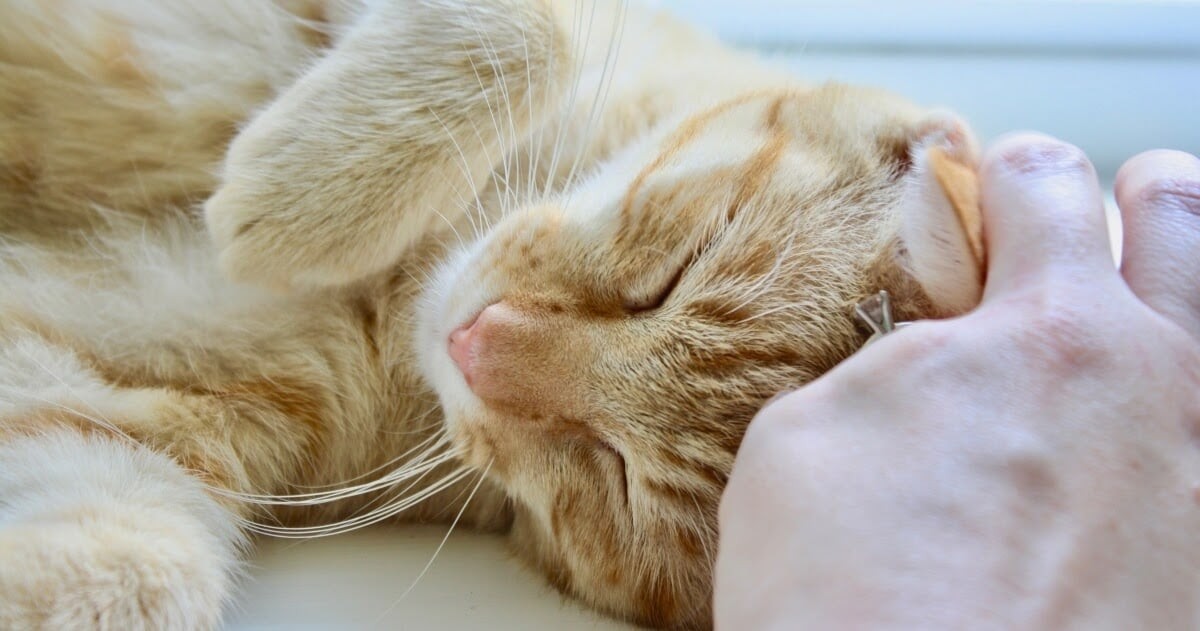As a devoted cat owner, you’ve likely experienced that adorable yet sometimes puzzling behavior: your cat gently bumping their head against you. This isn’t aggression; it’s actually a sweet gesture known as head bunting, and it’s a key way your feline friend communicates with you. Let’s dive into the reasons behind this charming feline action and understand what your cat is trying to tell you when they headbutt you.
The Secret is in the Scent: Why Cats Headbutt
Cats possess scent glands in several areas of their bodies, notably on their head, temples, cheeks, and the base of their ears. These glands secrete pheromones, chemical signals that play a vital role in feline communication. When your cat headbutts you, they are essentially marking you with their scent. This isn’t about claiming ownership in a possessive way; instead, it’s a sign of comfort and security. By depositing their pheromones on you, your cat is saying, “I feel safe and secure with you.”
Think of it as your cat creating a familiar and comforting environment. Scent marking is a natural instinct for cats, helping them to define their territory and feel at ease within it. When they rub against furniture, doorframes, or even you, they are spreading their scent and establishing a sense of safety. This behavior stems from their ancestral roots. In wild cat colonies, head bunting was used amongst individuals to share scents, fostering a sense of community and trust. Therefore, when your cat headbutts you, it’s a profound compliment. It signifies that they trust you deeply and consider you part of their inner circle, their “colony.”
The use of products like FELIWAY Optimum, which mimics feline pheromones, can enhance this feeling of security and comfort for cats in their homes. This can be particularly beneficial in households with changes or stressors, helping cats feel more relaxed and secure in their environment.
More Than Just Scent: Unpacking Other Reasons for Cat Headbutting
Beyond scent marking for security and territory, headbutting serves other important functions in the feline world:
Affection and Bonding
Just as cats headbutt to create a sense of shared scent and safety within a group, they also use it to express affection and strengthen bonds. If you have multiple cats in your household, you might observe them headbutting each other. This is their way of reinforcing their friendly relationship and reminding each other that they are companions.
Seeking Attention
Cats are intelligent creatures, and they quickly learn what actions elicit a response from their humans. Headbutting can be a very effective way for a cat to get your attention. If your cat bumps their head against you and then perhaps nudges your hand under their head, it’s a clear invitation for some petting and affection, especially in their favorite spot around the head and ears. They’ve learned that this gentle head nudge often leads to positive interaction with you.
Marking Objects and Territory
Cats don’t just headbutt people; they also headbutt objects. You might see your cat rubbing their face on furniture legs, doorframes, or even new items brought into the house. This behavior is, again, about scent marking. By rubbing against these objects, they are declaring them as part of their safe and familiar territory. It’s their way of saying, “This is mine, and this is safe.” Even when visitors come into your home, a cat might cautiously approach and rub against their legs. This isn’t necessarily a sign of instant friendship, but rather the cat’s way of investigating the newcomer and marking them with their scent, essentially integrating them into their perceived territory – at least scent-wise!
When Headbutting Isn’t the Go-To: Other Signs of Feline Affection
It’s important to remember that every cat is an individual, and not all cats are avid headbutters. If your cat doesn’t frequently headbutt you, it doesn’t mean they don’t love or trust you. Cats express affection in a variety of ways. Look out for other positive signals such as slow blinks (often referred to as “cat kisses”), greeting you at the door, purring contentedly, or holding their tail upright when they are around you. These are all clear indicators of a happy and affectionate cat.
In conclusion, when your cat headbutts you, it’s a wonderful sign of affection, trust, and bonding. It’s a unique feline communication method rooted in scent marking and social behavior. So, the next time your cat graces you with a head bunt, understand it as the loving gesture it truly is and cherish this special moment of connection with your feline companion.

